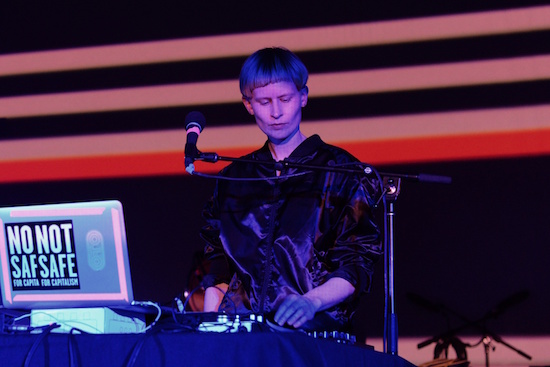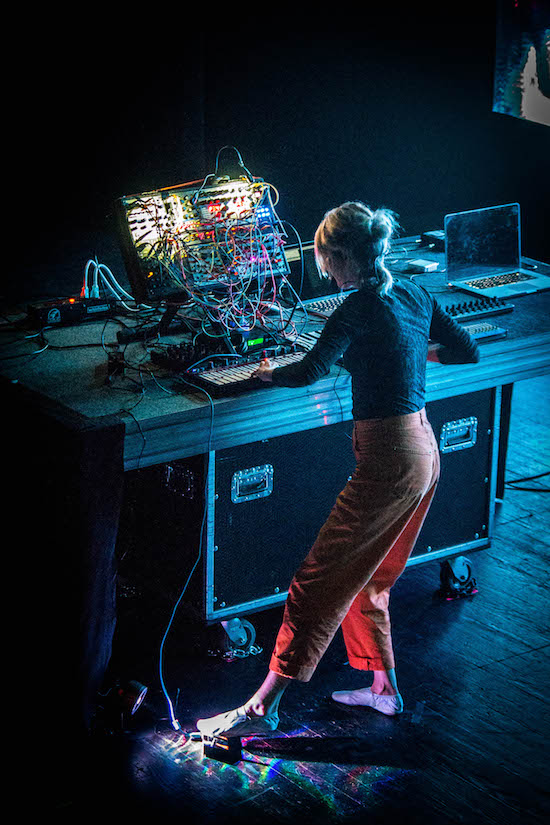Kaitlyn Aurelia Smith photo by Meg Cowan
Making room for underrepresented artists builds a better festival
When Moogfest announced its initial lineup consisting entirely of women, trans and non-binary artists and speakers, the response was somewhat divided. Amid positive feedback, internet trogs interjected: “Identity politics and PC culture run amok!” … “Well, actually, this is sexist against men.” At least one artist dropped off the bill, wanting to be chucked "in the pit with the boys." (As if only cis men provide adequate competition or validation?) But, when the dust cleared, and the second wave of acts was announced – which, yes, included some straight, cis-gendered white dudes – it became clear that what Moogfest was after was a radical sort of inclusivity, a fest that, while clearly prioritising the visibility of those mentioned above, makes ample room for underrepresented people of all colours, genders and orientations.
The result was the most diverse festival lineup I can remember, and one of the most stacked with talent – belying the notion, repeated by trolls more than once, that the only thing these artists had to offer was their demographic. Chelsea Manning, Umfang, Gavin Rayna Russom, Shabazz Palaces, Yves Tumor, Mhysa, Kelela, Fatima Al Qadiri, Suzanne Ciani, Katie Gately, Wajeed, DJ Stingray – I could go on and on, but let’s say the lineup was deep, and the real issue, as it generally is with well-curated things, would be choosing what to see. – BB
It’s okay to fall asleep at a festival
The first time I saw Kaitlyn Aurelia Smith it was at Unsound in Krakow, 2016. I didn’t know much about her work at this point. While I was sitting on a balcony, waiting for the gig to start, I drifted off into jetlag narcolepsy. My love of Smith began while emerging from deep sleep, absorbing selections from Ears, which had already begun to shift my rising consciousness from desperate exhaustion to warm, grinning fuzz. I woke up to calm modulation, her hands a flurry against a Buchla Music Easel as she sang into a headset beneath morphing abstract visuals of nothing in particular.
Seeing Smith at Moogfest was no less euphoric. Performing The Kid from start to finish, the live versions were booming and hinted at dance vibes present elsewhere at the fest, featuring a low-end well beyond what is represented on the record proper. The visuals created by Sean Hellfritsch complemented the cyclical cradle-to-the-grave theme of the record in neon pinks and blues, hinting at cellular forms becoming more cogent, bubbling up. Shards of salt, swishing feathers, wisps of DNA, and an iris becoming more recognisably human as the gig progressed.
One thing that strikes me about Smith is how hard she works on stage. Standing sidelong to the audience, it sometimes looks as though she’s just ahead of a delay, singing harmonies with her own echo, triggering with bare feet when not caught up in a one-legged, stomp-and-sway dance, patching cords, playing keys. I quietly hero-worship from my vantage point, knowing how it could all fall apart – and given the analogue nature of her gear – how unforgiving it all is, and how fluid she makes it all seem. – KG
Old heads still deliver
Full disclosure: Kristen and I were at Moogfest because she was on the bill twice, giving a talk related to her upcoming book and premiering a film and its accompanying score. Noted author and vocoder historian Dave Tompkins was there to do the post-screening Q&A, after which our thoughts turned to hip-hop (as they usually do when Dave is around).
Initially, I’ll admit to being skeptical of what seemed like an overabundance of legacy hip-hop acts on the bill. But as the day wore on, and we took in one act after another, it became increasingly clear that these guys are pro, wrecking the crowd as a matter of course. From Pete Rock and A Tribe Called Quest’s Ali Shaheed Muhammad’s outdoor sets at a refurbished tobacco factory, to J Rocc making mincemeat of James Brown and ‘Apache’ beneath an inexplicably jacked projection of a baby messing around with turntables, the old heads weren’t effing around, they were there to destroy. Pound for pound, minute for minute, these were some of the most purely entertaining sets of the festival, while simultaneously delivering some of its most crushing sonics.
When KRS-One took the stage with Freddie Foxx – a legend in his own right – demanding that the sound guy engage in sonic warfare with both the audience and historic Carolina Theatre, he complied, probably gleefully, allowing Kris to leave his mark on both the building’s weathered foundation and our guts, his ferocity seemingly undiminished beneath a monumental I AM HIP HOP. For a few minutes at least, we almost believe it. – BB

Jenny Hval photo by Jake Thomas
It’s okay to talk about ghosts in public
Notes scribbled from the same balcony which the night before brought tranquil swells from Kaitlyn Aurelia Smith, but now I’m witnessing Emptyset use the deepest frequency impulses imaginable to interrogate the limits of their (and our) environment:
"I imagine this is what it feels like to be listening to the outside, from within the resonant cavity tube of the espionage listening device known as ‘The Thing’. Caught up on the wrong side of a space, which was never the space you thought you knew anyways. The twang is making my nose itch and is liquifying the theatre, metaphysically and physically. The light fixture behind me is rattling off-queue, my camera won’t focus, my eyes won’t focus. If intelligence in architecture is real, it feels like something is being conjured up in here."
I message a friend completely sober. A two-word description of what I’m experiencing: "Bass drunk."
Paul and James of Emptyset are standing onstage in front of a table of black box mysteries and simple visuals. Analogue lines, like a longform version of the moment when a cathode ray television tube fades off and sines up into the dark. The audience holds off on clapping between songs, until someone below can’t take it anymore and lets off with a siren "Woo!" Space rings around itself. Numinous is the key descriptor here, that three-part, experiential encounter of belief: something that is "wholly other", an overwhelming power, accompanied by a silent reaction. In this case, the numinous is filtered through an alternating assault of sound and silence.
The following day, I attend a workshop run by the band. Unsurprisingly, there is a lot of talk about the importance of rules and systems, but I also feel vindicated in my impressions of the live show when discussion shifts to imprints, feedback, recursion, and intelligence. There is talk of recording Medium in the purportedly haunted Woodchester Mansion, of creating a circuit with the ionosphere at CTM with their project Signal. When an audience member raises his hand to ask a question, they respond: "Are you going to tell us a ghost story? We want to hear all of your ghost stories." – KG
Location is key, ambience is everything
Durham, North Carolina, the home of Moogfest for the past three years, is a pretty great place for a four-day festival. Its city centre is small and very walkable with tonnes of great food, allowing Moogfest to fully use its handful of venues, each markedly different from the others. But the particular qualities of these venues create a tricky logistical problem for Moogfest. Namely, how to ensure that each artist ends up at the most appropriate venue for both their music and audience? Sometimes, gambits pay off. Booking Smerz at the First Presbyterian Church (which in previous years hosted dreamier acts like Gwenno and Colleen) was a brilliant move. The duo’s bent R&B was transformed by the acoustics of the space into something huge and full and heavy, almost a counterpoint to their recordings, which can sometimes feel just a bit too thin. Their set was a surprise highlight of the fest for me.
On the flip side, two of my most anticipated performances were marred by poor venue selection. The Pinhook is a charming, tiny, dirtbag bar, perfect for dynamic, adventurous sets like DJ Haram’s. Its slightly cramped layout lends itself to a party. By contrast, an artist like Carla dal Forno, whose recordings are sublime downers, feels paradoxically small in such a venue, drained of energy. Not intimate, but inert. Her set sounded great, but required some ambience and atmosphere to really work, not a bunch of people crammed together, still as posts. It would’ve been perfect in a church.
Jenny Hval, easily one of my favorite artists working today, did her best to fill the Armory with an off-kilter, trickster’s energy, but the cavernous space and its bizarrely quiet, muddy sound (perhaps a result of livestreaming requirements and/or Moogfest’s Spatial Sound system – which sounded less than impressive to these admittedly damaged ears) allowed the chattering, restless audience to drown her out. Not having her perform on the stage of the Carolina Theatre was a real missed opportunity, one compounded by the playful theatricality of Hval’s set.
But all fests of this size disappoint at least once or twice. The question is, in an increasingly crowded market in which most festivals in the States seem superfluous at best, does Moogfest justify its existence? The answer here is a resounding yes. Between its adventurous, diverse, forward-thinking programming and intellectual rigour, it’s one of the very few American festivals worth mentioning in the same breath as superlative European institutions like Unsound. – BB


